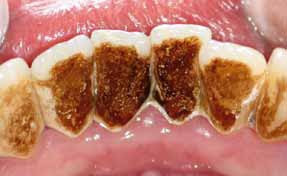ygoogle |
| []).push({}) ;
“Why are my teeth sensitive to cold?”
This is one of the most common conditions and complaints reported to me by patients. This is a rather ubiquitous problem shared by many people as evidenced by the plethora of dental products on the market catering to sensitive teeth, Sensodyne Toothpaste being the most readily recognized.
Cold sensitivity does not necessarily mean that you have a serious dental problem looming. But while the cause may be not be serious in nature, the noxious feeling brought on by something cold can be rather startling and severe. This is because the only sensation that the nerve of a tooth registers is pain. Regardless of the type of stimulus (hot, cold, sweet, etc.) if the dental nerve is agitated, it will hurt.
The intensity of cold sensitivity can run the spectrum from mild inconvenience to intense “stopped me in my tracks” pain. The purpose of this soliloquy on cold sensitivity is to identify the most common causes and offer some practical solutions.
8 Reasons That Teeth Are Sensitive To Cold
Plaque Build-Up And Gum InflammationPeriodontal (gum) disease can be a cause of cold sensitivity whether in its earliest stages as Gingivitis, or more advanced. A build-up of bacterial plaque is not only potentially destructive to your gums and bone, which support your teeth; it is also an irritant, which can lower the threshold at which pain is perceived. In other words, the presence of bacterial plaque can actually make your teeth more sensitive.
I have seen more than a few patients with healthy mouths come into my office complaining of general cold sensitivity when all they need to resolve the issue is a gentle and thorough cleaning. Often times these are longstanding patients who are overdue for their periodic re-care visit. Additionally, the persistent presence of plaque can promote periodontal disease which can lead to gum recession.
Gum RecessionReceding or receded gums are common causes of cold sensitivity. When your gums are not firmly attached to a tooth, as in the case of gum disease, they can actually pull away from the tooth and creep down (or up if it’s an upper tooth) leaving exposed root surface. Unlike the normally exposed part of your tooth, the root does not have enamel protection and therefore is more reactive to temperature, especially cold.
Aggressive brushing with a hard-bristled toothbrush or excessive pressure when using an electric toothbrush can cause gum recession and the resultant cold sensitivity. As I have stated in previous postings, tooth brushing should be a gentle process that is confined to the tooth structure. Don’t scrub your gums, either. And always be mindful that you are not scouring bathroom tile! It is very easy to damage your gums and cause recession with improper brushing techniques. For tips on tooth brushing, link here: The Dos and Don’ts of Brushing Your Teeth.
Patients who have had periodontal surgery or orthodontic treatment may also have gum recession. Aside from proper brushing techniques, fluoride rinses (both over-the-counter and prescription strength) and desensitizing toothpaste can help decrease sensitivity over time.
Bruxism And ClenchingGrinding or clenching of one’s teeth are commonly referred to as parafunctional habits. Bruxing (grinding) and clenching teeth together can be a potentially destructive pattern of behavior in which tremendous forces are placed on your teeth. This can result in a loss of tooth structure on the biting surfaces (dentist’s call this occlusal wear) or near the gum-line (abfractures). As your tooth wears down, the sensitive dentin can be exposed, creating temperature sensitivity, especially to cold.
Because grinding and clenching can generate upwards of 500 lbs. per square inch of force, your teeth themselves can be so traumatized to make them more reactive to cold stimulus.
Aside from temperature sensitivity, bruxism and clenching can cause premature tooth loss, muscle tenderness and TMJ symptoms. Many people who clench or grind their teeth benefit from an occlusal nightguard, which protects the teeth from wear during sleep.
CavitiesTooth decay is one of the most common reasons that you may have a tooth that is sensitive to cold. In fact, cold sensitivity is one of the earliest symptoms of a cavity. Unlike the previous conditions, cold sensitivity due to a cavity is more localized and is restricted to the involved tooth. See your dentist!
Broken Teeth or Lost FillingsFor reasons similar to teeth that have cavities, if you have a tooth or teeth that are broken, cracked or if you have lost all or part of a filling, cold sensitivity can arise. Generally this heightened sensitivity is because part of your tooth’s structure is exposed. Sometimes, if a break is severe, the nerve can be exposed causing an actual toothache. Clearly in any of these situations, a visit to the dentist is warranted. Go!
Acidic Food and BeveragesBeware of the many beverages on the market promoted by their manufacturers to be healthy alternatives to other drinks, such as soda pop. Many of these so-called vitamin waters, energy drinks, and sports drinks are highly acidic and if consumed in large quantities can cause your teeth’s structure to break down. Acidic drinks are caustic and can actually dissolve tooth structure much the same way acids from bacterial plaque cause cavities!
The problem lies in how often you consume the offending drinks and the amount of time they are allowed to linger in your mouth. It’s best not to swish a drink while consuming as it prolongs the acid attack on your teeth. Also, do not brush your teeth for at least 30 minutes after consumption because the “softened” enamel or dentin is more susceptible to abrasion. This also applies to foods such as citrus fruits, pickles and vinegar that also have low ph. values (acidic). For more on this issue, please see: Is your Favorite Beverage Eroding your Tooth Enamel?
Recent Dental Treatment
The placement of large restorations, fillings or crowns can also provoke sensitivity. Restorative dentistry is actually a kind of “bloodless surgery” but it’s surgery nonetheless. Vital tissue is cut, albeit with a dental drill and not a scalpel, and the nerve of your tooth can be traumatized and sensitized by it. It is not uncommon for a recently restored tooth to have cold sensitivity that can last for several days.
The placement of large restorations, fillings or crowns can also provoke sensitivity. Restorative dentistry is actually a kind of “bloodless surgery” but it’s surgery nonetheless. Vital tissue is cut, albeit with a dental drill and not a scalpel, and the nerve of your tooth can be traumatized and sensitized by it. It is not uncommon for a recently restored tooth to have cold sensitivity that can last for several days.
If the condition lingers beyond this time frame, you should revisit your dentist. Often a simple “bite adjustment” can resolve the issue, especially if the filling was a bit too high. But don’t wait. Delaying a needed refinement can prolong your recovery time. Sometimes a cleaning or scaling can lead to temporary cold sensitivity.
If you experience cold sensitivity after a routine cleaning at your dentist’s office, try to be patient. Plaque removal can sometimes expose root surfaces that were “protected” from the elements by the very plaque that needed to be removed.
Acute PulpitisAcute pulpitis is an inflammation of the dental nerve. Generally the symptoms of this condition are more severe than just slight cold sensitivity. Not only are the teeth especially responsive to cold, the pain lingers even after the stimulus is removed. The intensity of this condition often necessitates root canal therapy. If you are experiencing this…go to your dentist right now.
Cold sensitivity is often more of a quality of life issue than a progressive pathological process that will worsen over time. In other words, normally there is nothing seriously wrong. I use various treatment approaches including conservative over-the-counter remedies, fluoride prescriptions, desensitizing treatments, as well as more definitive dental procedures such as bonding or gum grafting (to name just two). The proper management of cold sensitivity depends on the cause, the severity and the duration.
If you experience cold sensitivity, speak to your dentist for advice. If you develop sudden cold sensitivity or any other type of severe sensitivity, make an appointment as soon as possible.
About author: Dr Disha SIngh, is Managing Director of Odontos Chain of Dental Clinics, which has been setting benchmarks in Dental care for last 7 years. With a vision to provide quality dental care in every corner of the country, Odontos under the guidance of Dr Disha has been striving hard. This article has been authored with inputs from Dr. Michael Sinkin who is a NYC dentist that has been in practice for over two decades. He truly cares about the experience his patients have and takes great pride in making them feel relaxed and comfortable during every visit. Come in for an appointment and experience a different kind of dental practice.


































